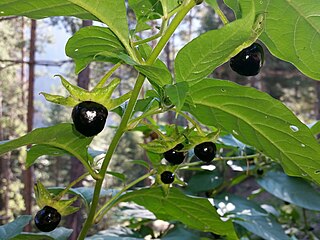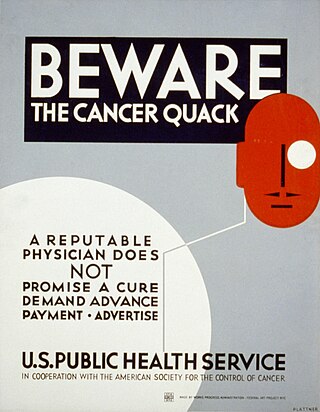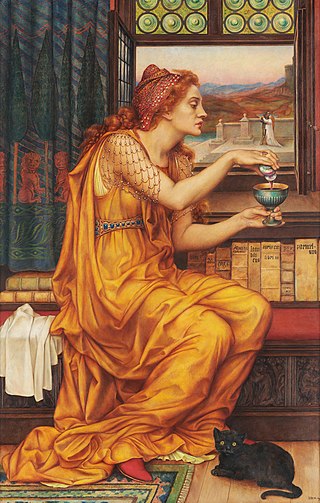
Snake oil is a term used to describe deceptive marketing, health care fraud, or a scam. Similarly, snake oil salesman is a common label used to describe someone who sells, promotes, or is a general proponent of some valueless or fraudulent cure, remedy, or solution. The term comes from the "snake oil" that used to be sold as a cure-all elixir for many kinds of physiological problems. Many 18th-century European and 19th-century United States entrepreneurs advertised and sold mineral oil as "snake oil liniment", making claims about its efficacy as a panacea. Patent medicines that claimed to be a panacea were extremely common from the 18th century until the 20th century, particularly among vendors masking addictive drugs such as cocaine, amphetamine, alcohol, and opium-based concoctions or elixirs, to be sold at medicine shows as medication or products promoting health.

Paregoric, or camphorated tincture of opium, also known as tinctura opii camphorata, is a traditional patent medicine known for its antidiarrheal, antitussive, and analgesic properties.

Atropa bella-donna, commonly known as deadly nightshade or belladonna, is a toxic perennial herbaceous plant in the nightshade family Solanaceae, which also includes tomatoes, potatoes and aubergine (eggplant). It is native to Europe and Western Asia, including Turkey, its distribution extending from England in the west to western Ukraine and the Iranian province of Gilan in the east. It is also naturalised or introduced in some parts of Canada, North Africa and the United States.

Quackery, often synonymous with health fraud, is the promotion of fraudulent or ignorant medical practices. A quack is a "fraudulent or ignorant pretender to medical skill" or "a person who pretends, professionally or publicly, to have skill, knowledge, qualification or credentials they do not possess; a charlatan or snake oil salesman". The term quack is a clipped form of the archaic term quacksalver, derived from Dutch: kwakzalver a "hawker of salve" or rather somebody who boasted about their salves, more commonly known as ointments. In the Middle Ages the term quack meant "shouting". The quacksalvers sold their wares at markets by shouting to gain attention.

A patent medicine is a non-prescription medicine or medicinal preparation that is typically protected and advertised by a trademark and trade name, and claimed to be effective against minor disorders and symptoms, as opposed to a prescription drug that could be obtained only through a pharmacist, usually with a doctor's prescription, and whose composition was openly disclosed. Many over-the-counter medicines were once ethical drugs obtainable only by prescription, and thus are not patent medicines.

A charlatan is a person practicing quackery or a similar confidence trick in order to obtain money, power, fame, or other advantages through pretense or deception. One example of a charlatan appears in the Canterbury Tales story "The Pardoner's Tale," with the Pardoner who tricks sinners into buying fake religious relics. Synonyms for charlatan include shyster, quack, or faker. Quack is a reference to quackery or the practice of dubious medicine, including the sale of snake oil, or a person who does not have medical training who purports to provide medical services.

Flying ointment is a hallucinogenic ointment said to have been used by witches in the practice of European witchcraft from at least as far back as the Early Modern period, when detailed recipes for such preparations were first recorded and when their usage spread to colonial North America.
A panacea is any supposed remedy that is claimed to cure all diseases and prolong life indefinitely. Named after the Greek goddess of universal remedy Panacea, it was in the past sought by alchemists in connection with the elixir of life and the philosopher's stone, a mythical substance that would enable the transmutation of common metals into gold. Through the 18th and 19th centuries, many "patent medicines" were claimed to be panaceas, and they became very big business. The term "panacea" is used in a negative way to describe the overuse of any one solution to solve many different problems, especially in medicine. The word has acquired connotations of snake oil and quackery.

Apothecary is an archaic English term for a medical professional who formulates and dispenses materia medica (medicine) to physicians, surgeons and patients. The modern terms 'pharmacist' and 'chemist' have taken over this role.

The elixir of life, also known as elixir of immortality, is a potion that supposedly grants the drinker eternal life and/or eternal youth. This elixir was also said to cure all diseases. Alchemists in various ages and cultures sought the means of formulating the elixir.

Witchcraft has been present throughout the Philippines even before Spanish colonization, and is associated with indigenous Philippine folk religions. Its practice involves black magic, specifically a malevolent use of sympathetic magic. Today, practices are said to be centered in Siquijor, Cebu, Davao, Talalora, Western Samar, and Sorsogon, where many of the country's faith healers reside. Witchcraft also exists in many of the hinterlands, especially in Samar and Leyte; however, witchcraft is known and occurs anywhere in the country.

Daffy's Elixir is a name that has been used by several patent medicines over the years. It was originally designed for diseases of the stomach, but was later marketed as a universal cure. It remained a popular remedy in Britain and later the United States of America throughout the eighteenth and nineteenth centuries.

Theriac or theriaca is a medical concoction originally labelled by the Greeks in the 1st century AD and widely adopted in the ancient world as far away as Persia, China and India via the trading links of the Silk Route. It was an alexipharmic, or antidote for a variety of poisons and diseases. It was also considered a panacea, a term for which it could be used interchangeably: in the 16th century Adam Lonicer wrote that garlic was the rustic's theriac or Heal-All.

The history of poison stretches from before 4500 BCE to the present day. Poisons have been used for many purposes across the span of human existence, most commonly as weapons, anti-venoms, and medicines. Poison has been heavily studied in toxicology, among other sciences, and its use has led to several technological innovations.

The Vereniging tegen de Kwakzalverij or VtdK is a Dutch organisation that investigates the claims of alternative medicine and opposes quackery.

Swaim's Panacea was an American patent medicine sold by William Swaim (1781–1846) of Philadelphia, starting in approximately 1820, with formulations still being sold into at least the 1920s. It was advertised to cure various diseases including scrofula, mercurial disease, deep-seated syphilis, rheumatism, sores, swellings, etc.

Godfrey's Cordial was a patent medicine, containing laudanum in a sweet syrup, which was commonly used as a sedative to quiet infants and children in Victorian England. Used mostly by mothers working in agricultural groups or industry, it ensured that she could work the maximum hours of her employment, without being disturbed by her infant, and thus increased the family income. It was also used by nurses and baby-minders to enable them to neglect their duties if they wished.

Arthur Joseph Cramp was a medical doctor, researcher, and writer. He served as director of the American Medical Association's (AMA) Propaganda for Reform Department from 1906 to 1936. He was a regular contributor to the Journal of the American Medical Association (JAMA). Cramp was "a bitter opponent of proprietary and medicinal abuses." His three volume series on 'Nostrums and Quackery', along with his public lectures to schools, professional groups, and civic organizations across the country, helped bring awareness to the problem of patent medicines or nostrums, by subjecting the claims to scientific analysis. He was critical of the 1906 Pure Food and Drug Act, and advocated stronger regulation of product labeling and advertising. In an article announcing his death, the AMA called him "a pioneer in the fight against quackery and fraud in the healing arts."

A love potion is a magical liquid which supposedly causes the drinker to develop feelings of love towards the person who served it. Another common term to describe the potion, philtre, is thought to have originated from the ancient Greek term philtron, via the French word philtre.

























